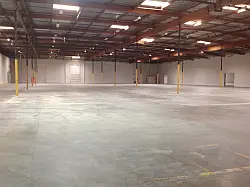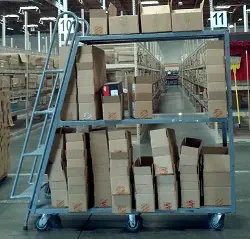Planning a Warehouse: A guide to new warehouse design and setup
How to Set Up a New Warehouse
This materials handling article focuses on helping warehouse managers move into or set up a new warehouse. The guides in this series will include:
- Warehouse Racking Design
- Materials Handling Equipment Planning
- Warehouse Budgeting
- Commercial Real Estate Location Advice
- Square Footage Planning
Warehouse Racking Design Guide
When considering a new warehouse, you will want to design the racking around the product you will store. Your racking plan will take into consideration:
- number of SKUs
- How many pallets will be stored
- How many orders to be picked per day
- The number of pallets an order makes up
- How many line items per order
- And number of pieces per line
This is the crucial starting point for designing pallet racking for your new warehouse design. Without this information, you will only be able to guess at the warehouse layout. With the information, through this step by step guide, you will be able to design your warehouse for both space and productivity.
Why product SKUs matter
SKUs means stock keeping units. SKUs or part numbers represent all the unique products stored in the warehouse. These must be account for and considered in a warehouse layout, and in the new warehouse design process.
You need to know the number of SKUs that will be stored in a new warehouse. This data is important to have on hand, as you will need to ensure that the new warehouse design provides adequate pick locations for the different types of products stored. How quickly a picker accesses the different SKUs will determine the productivity of the warehouse. The greater the distance between SKUs, the more labor the warehouse will need.
Pallet Rack Storage – Present, Future and Growth Needs
Many businesses start out looking for a new warehouse based on square footage. For example, if the current warehouse space is 50,000 square and does not meet the current storage needs, then doubling it to 100,000 sq ft will certainly help. Is this true?
The first questions when planning a new warehouse should be:
- How many pallets do we store now?
- What is our rate of growth?
- And, how many pallets will we store at the end of the new lease?
The present, future, and growth needs should all be considered in a plan for a new warehouse layout.
Warehouse Order Profile
 What does a business’ order profile have to do with a new warehouse? A lot, as it turns out. How a business picks orders will determine how products should be stored. How they are stored will determine the space required in the warehouse. How many orders are picked will determine:
What does a business’ order profile have to do with a new warehouse? A lot, as it turns out. How a business picks orders will determine how products should be stored. How they are stored will determine the space required in the warehouse. How many orders are picked will determine:
- The square footage allocated for dock and staging areas.
- Materials handling equipment required, including pallet trucks or order pickers.
- Storage media. ie pallet rack.
- Picking media such as case flow, pallet flow, vertical lift modules, carousels, pick modules.
You need to understand how an order is picked and how many are picked per day. This has a huge impact on the new warehouse design.
The standard approach to understanding an order is to analyze:
- Order per day
- Cube of the order (number of pallets/cases)
- Lines per order (how many stops in building the order)
- Pieces per line (the duration of the stop/mode of picking)
Having this information builds a picture of how an efficient warehouse will look from a picking standpoint. You then build the warehouse design backwards. This includes knowledge of how the order leaves the door back to the picking area, to the replenishment area (overstock), and to the receiving area. This process will help complete the design of the warehouse, and indicate the number of square feet needed for the new warehouse.
New warehouse setup and design summary
This introduction to the basics of new warehouse setup and how to plan a new warehouse. It is the first step in any warehouse design. Look in the New Warehouse Planning Guide section for more articles and ideas around planning a new warehouse.


